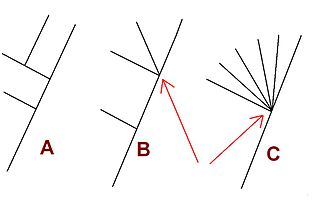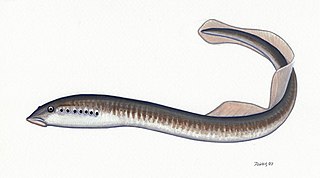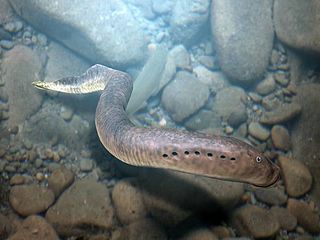
The sea lamprey is a parasitic lamprey native to the Northern Hemisphere. It is sometimes referred to as the "vampire fish".

Spalax is a genus of rodent in the family Spalacidae, subfamily Spalacinae. It is one of two extant genera in the subfamily Spalacinae, alongside Nannospalax.

An internal node of a phylogenetic tree is described as a polytomy or multifurcation if (i) it is in a rooted tree and is linked to three or more child subtrees or (ii) it is in an unrooted tree and is attached to four or more branches. A tree that contains any multifurcations can be described as a multifurcating tree.

The pouched lamprey, also known as the piharau in the North Island, korokoro,kanakana in the South Island, or wide-mouthed lamprey, is a species in the genus Geotria, which is the only genus in the family Geotriidae. The second species in the genus is the Argentinian lamprey, which was revalidated as a separate species in 2020. The pouched lamprey is native to the southern hemisphere. It spends the early part of its life in fresh water, migrating to the sea as an adult, and returning to fresh water to spawn and die.

Geotria is the only genus in the lamprey family Geotriidae. It has 2 known species: Geotria australis and Geotria macrostoma. Both species were considered conspecific until G. macrostoma was revived in a 2020 study.

The Pacific lamprey is an anadromous parasitic lamprey from the Pacific Coast of North America and Asia in an area called the Pacific Rim. It is a member of the Petromyzontidae family. The Pacific lamprey is also known as the three-tooth lamprey and tridentate lamprey.

The chestnut lamprey is a species of lamprey.

Mordacia is a genus of lamprey, the sole genus of the family Mordaciidae, also known as the southern topeyed lampreys.

The northern brook lamprey is a freshwater fish in the family Petromyzontidae. It is closely related to the silver lamprey and may represent an ecotype of a single species with I. unicuspis.

Scardinius is a genus of ray-finned fish in the family Cyprinidae commonly called rudds. Locally, the name "rudd" without any further qualifiers is also used for individual species, particularly the common rudd. The rudd can be distinguished from the very similar roach by way of the rudd's upturned mouth, allowing it to pick food items such as aquatic insects from the surface of the water with minimal disturbance.

Eudontomyzon is a genus of lamprey in the family Petromyzontidae. Most species are found in Eastern Europe.
The Greek lamprey is a species of jawless fish in the Petromyzontidae family. It is endemic to Greece. Its natural habitats are rivers and freshwater springs. It is threatened by habitat loss. This species may be better included in the genus Caspiomyzon. It is the most endangered species of lamprey. It lives only in the Strymon and Louros river basins.
The Kern brook lamprey is a species of lamprey in the Petromyzontidae family endemic to the United States. It is found on the east side of San Joaquin Valley, in lower Merced, Kaweah, Kings, and San Joaquin rivers in California. It can grow to up to around 14 centimeters, and is characterized by its grayish brown and white coloring, and black spots on its fins.

Lampetra is a genus of lampreys in the family Petromyzontidae.

Lethenteron is a genus of lamprey in the family Petromyzontidae.
Pungitius hellenicus, the Greek ninespine stickleback or ellinopygósteos, is a species of fish in the family Gasterosteidae. It is endemic to Greece. Its natural habitats are rivers and freshwater spring. It is threatened by habitat loss and considered critically endangered in the International Red List of IUCN, Bern Convention.

The basal angiosperms are the flowering plants which diverged from the lineage leading to most flowering plants. In particular, the most basal angiosperms were called the ANITA grade, which is made up of Amborella, Nymphaeales and Austrobaileyales.

Lampreys are an ancient lineage of jawless fish of the order Petromyzontiformes. The adult lamprey are characterized by a toothed, funnel-like sucking mouth. The common name "lamprey" is probably derived from Latin lampetra, which may mean "stone licker", though the etymology is uncertain. Lamprey is sometimes seen for the plural form.
The Caspian lamprey, Caspiomyzon wagneri, is a species of lamprey native to the Caspian Sea, and a member of the Petromyzontidae family. This species is a non-parasitic lamprey that feeds on animal carcasses.

Mesomyzon mengae is an extinct lamprey from freshwater strata of the Early Cretaceous-aged Yixian Formation, in China.














